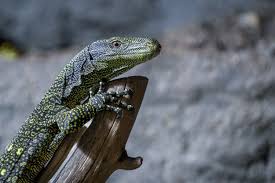Deep within the dense rainforests of Papua New Guinea lives one of the most magnificent and mysterious reptiles on Earth — the crocodile monitor (Varanus salvadorii). Renowned for its incredible length, agility, and prehistoric appearance, this striking lizard is often regarded as the world’s longest monitor species.
Despite its intimidating name and looks, the crocodile monitor is a shy, elusive creature rarely seen in the wild. It is a vital part of the island’s ecosystem and a true symbol of the natural diversity found in New Guinea’s forests.
This article explores everything you need to know about the crocodile monitor — its habitat, size, diet, behavior, and conservation importance.
What Is a Crocodile Monitor?
The crocodile monitor, also known as the Papuan monitor, is a large species of monitor lizard belonging to the genus Varanus. It is closely related to the Komodo dragon (Varanus komodoensis), but it has evolved unique traits to adapt to life high in the trees of Papua New Guinea’s tropical lowlands.
The name “crocodile monitor” comes from its reptilian head and serrated teeth, which resemble those of a crocodile. However, unlike its more famous cousin, the Komodo dragon, the crocodile monitor is arboreal — meaning it spends much of its life in trees.
Physical Characteristics
The crocodile monitor is an impressive animal in both size and appearance. It combines the power of a large terrestrial predator with the agility of a skilled climber.
1. Size and Length
- The crocodile monitor can grow up to 8 to 10 feet (2.5–3 meters) in total length, making it the longest lizard in the world, though not the heaviest.
- Much of this length comes from its extraordinarily long tail, which can make up nearly two-thirds of its total body size.
2. Weight
Adult crocodile monitors typically weigh between 20 to 40 pounds (9–18 kg), though some exceptional individuals may exceed that.
3. Color and Pattern
Their skin is covered in dark black or greenish scales, marked with striking yellow spots or bands along the body and tail. This pattern provides excellent camouflage among the dappled sunlight of the forest canopy.
4. Head and Teeth
The head is long and pointed, with powerful jaws lined with sharp, serrated teeth designed for gripping and tearing flesh.
5. Tail and Claws
Their tails are prehensile and muscular, helping them balance and defend themselves, while their claws enable them to climb trees and grip branches effortlessly.
Natural Habitat
Crocodile monitors are native to New Guinea, an island known for its tropical rainforests, swamps, and mountainous terrain. They are found mainly in:
- Lowland and coastal rainforests
- Mangrove areas and river edges
- Forest canopies and tree hollows
They prefer humid, dense environments where they can hunt, climb, and hide effectively. Their arboreal lifestyle sets them apart from most other large reptiles, which are typically ground-dwellers.
Diet and Feeding Behavior
Crocodile monitors are carnivorous opportunists, feeding on a wide range of prey found in their forest habitat. Their diet typically includes:
- Birds and their eggs
- Small mammals
- Reptiles and amphibians
- Carrion (dead animals)
- Occasionally fish or insects
Because of their size and stealth, they are capable hunters. Their long tongues — like those of snakes — help them detect scent trails, while their powerful limbs and sharp claws make them expert climbers and ambushers.
They are known to strike quickly, using their jaws and teeth to deliver deep wounds, followed by rapid consumption of the prey.
Behavior and Temperament
1. Arboreal Lifestyle
Unlike most other large monitor lizards, the crocodile monitor spends much of its time in trees. This unique adaptation allows it to escape predators and hunt for arboreal prey such as birds and bats.
2. Solitary Nature
They are solitary animals, coming together only for mating. They prefer to avoid confrontation, though they can become aggressive if threatened.
3. Defensive Behavior
When cornered, crocodile monitors can be dangerous. They use their long tails as whips, their teeth to bite, and their claws for defense. Despite this, they generally avoid human interaction.
4. Communication
Like many monitors, they communicate through body language, tongue flicking, and scent marking. Males often engage in dominance displays or wrestling during the breeding season.
Reproduction and Life Cycle
Mating Season
Crocodile monitors are believed to breed during the wet season, when food is abundant.
Egg Laying
Females lay between 6 to 12 eggs in secure locations, such as tree hollows or termite mounds, where the temperature and humidity remain stable.
Incubation
The eggs take about 6 to 8 months to hatch. Hatchlings are fully independent from birth, measuring around 16–20 inches (40–50 cm) in length.
Lifespan
In captivity, crocodile monitors can live up to 15–20 years, though their lifespan in the wild is less certain due to predation and habitat loss.
Crocodile Monitor vs. Komodo Dragon
Both the crocodile monitor and the Komodo dragon are impressive members of the monitor lizard family, but they differ significantly:
| Feature | Crocodile Monitor | Komodo Dragon |
|---|---|---|
| Scientific Name | Varanus salvadorii | Varanus komodoensis |
| Habitat | Forests of Papua New Guinea | Islands of Indonesia |
| Lifestyle | Arboreal (tree-dwelling) | Terrestrial (ground-dwelling) |
| Length | Up to 10 feet | Up to 9 feet |
| Weight | 20–40 lbs | 150–200 lbs |
| Diet | Birds, mammals, reptiles | Large mammals, carrion |
| Temperament | Shy, elusive | Bold, predatory |
While the Komodo dragon is heavier and more powerful, the crocodile monitor holds the record for the longest lizard thanks to its extremely long tail.
Importance in the Ecosystem
Crocodile monitors play a key role as mid-level predators in their rainforest ecosystem. By hunting birds, rodents, and other small animals, they help regulate prey populations and maintain balance in the food chain.
Their climbing and scavenging habits also aid in nutrient recycling, as they feed on carrion and return nutrients to the forest floor.
Conservation Status
The crocodile monitor is currently listed as “Least Concern” by the International Union for Conservation of Nature (IUCN), but local populations face increasing threats due to:
- Deforestation and habitat loss from logging and agriculture
- Illegal wildlife trade (collected for the exotic pet market)
- Hunting for meat and skins in rural areas
Because of their shy nature and remote habitat, their population numbers are difficult to estimate, but conservationists stress the importance of protecting Papua New Guinea’s forests to ensure their survival.
Interaction with Humans
Crocodile monitors are rarely seen by humans due to their secretive behavior and remote range. In captivity, they are sometimes kept by experienced reptile handlers and zoologists, but they are not suitable as pets.
Their intelligence and strength require specialized enclosures, constant humidity, and large climbing areas — conditions that are difficult to replicate outside of professional facilities.
For most people, the best way to appreciate crocodile monitors is through documentaries, zoos, and conservation programs dedicated to studying their ecology.
Fascinating Facts About Crocodile Monitors
- They are believed to have the longest tail-to-body ratio of any lizard species in the world.
- Their teeth are serrated, much like shark teeth, designed for slicing through flesh.
- They can cling to vertical tree trunks using their strong claws and tail.
- When threatened, they may hiss loudly and lash their tails like a whip.
- Despite their size, they can move swiftly and silently through the forest canopy.
FAQs About Crocodile Monitors
Q1: Are crocodile monitors dangerous to humans?
Not typically. They are shy and avoid humans, but can inflict serious bites if threatened or handled improperly.
Q2: What do crocodile monitors eat in captivity?
They are fed a diet of rodents, chicks, fish, and eggs — similar to their wild diet.
Q3: How big do crocodile monitors get?
They can reach up to 10 feet in total length, though most individuals are around 7–8 feet.
Q4: Can crocodile monitors swim?
Yes. They are excellent swimmers and can cross rivers in search of food or mates.
Q5: Are crocodile monitors endangered?
Not currently, but their numbers are declining locally due to deforestation and illegal collection.
Conclusion
The crocodile monitor stands as one of nature’s most remarkable reptiles — a giant predator adapted not for the ground, but for the canopy of the rainforest. Its agility, intelligence, and beauty make it a marvel of evolution and a reminder of the biodiversity that thrives in Papua New Guinea.
While not as famous as its cousin, the Komodo dragon, the crocodile monitor is equally awe-inspiring in its own right. Protecting its forest habitat ensures not only the survival of this ancient species but also the preservation of one of the planet’s richest ecosystems.
So the next time you think of the world’s great reptiles, remember the silent giant of the trees — the crocodile monitor, the true master of New Guinea’s rainforest canopy.


